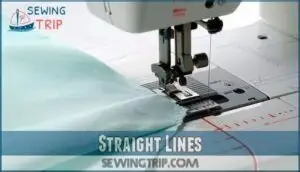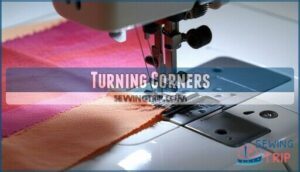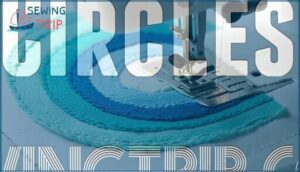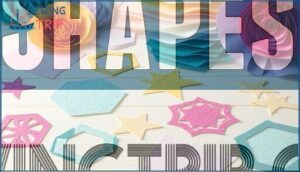This site is supported by our readers. We may earn a commission, at no cost to you, if you purchase through links.
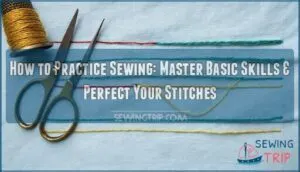 Start your sewing journey with simple exercises on scrap fabric. Practice straight lines first – they’re the foundation of every project.
Start your sewing journey with simple exercises on scrap fabric. Practice straight lines first – they’re the foundation of every project.
Once you’ve mastered those, move on to turning corners and sewing curves. Set up a dedicated practice routine, even if it’s just 15 minutes daily.
Use different thread colors to see your progress clearly. Don’t rush – muscle memory takes time to develop.
Focus on consistent seam allowances and steady speed rather than racing through stitches. Remember, even seasoned sewists started with wobbly lines that looked more like abstract art than straight seams.
Your practice sessions will reveal specific techniques that transform amateur attempts into professional-looking results. They will help you develop steady speed and master the art of sewing with consistent practice.
Table Of Contents
Key Takeaways
- Start with paper practice – You’ll develop muscle memory and hand-eye coordination by sewing on printable practice sheets without thread, focusing on straight lines, curves, and corners before touching fabric.
- Practice daily for consistency – You’ll build skills faster with 15-minute daily sessions rather than marathon practice periods, allowing your muscle memory to develop naturally.
- Use scrap fabric after paper – You’ll save money and reduce frustration by practicing new techniques on fabric scraps before moving to actual projects, making mistakes less costly.
- Focus on seam guides, not the needle – You’ll achieve straighter lines by watching the seam guide on your machine’s throat plate instead of the needle, maintaining consistent seam allowances throughout your stitching.
Why Learn to Sew?
Learning to sew opens doors to countless creative expression opportunities while saving money on alterations and clothing purchases.
You’ll discover the therapeutic benefits of working with your hands, finding calm in the rhythmic motion of stitching.
This versatile skill enables garment customization, transforming ordinary pieces into unique creations that reflect your personal style.
Sewing skills development leads to practical mending abilities, extending your wardrobe’s lifespan and reducing waste.
Novices often start with cotton fabric benefits due to its ease of use.
Beyond personal benefits, mastering these techniques creates job opportunities in fashion, alterations, and custom work.
The time and cost savings add up quickly when you can hem pants, repair tears, or create home décor items yourself.
Your sewing creativity flourishes as you gain confidence with basic techniques.
Whether you’re crafting quilts, designing costumes, or simply fixing a loose button, these fundamental skills serve as building blocks for more complex projects.
The satisfaction of creating something beautiful and functional with your own hands makes every practice session worthwhile.
Benefits of Sewing Proficiency
When you master sewing skills, you’ll save serious money on clothing alterations, repairs, and custom pieces while developing a valuable life skill.
Your newfound proficiency also opens doors to freelance opportunities, creative outlets, and the satisfaction of creating exactly what you envision.
Time and Cost Savings
With your own sewing machine and some fabric sourcing savvy, you’ll slash clothing costs dramatically.
DIY alterations cost pennies compared to tailor fees, while mending clothes extends garment life for years.
Upcycling projects transform old pieces into trendy new ones.
Pattern costs pay for themselves after just one successful project, making sewing practice a smart investment that saves hundreds annually, and through sewing practice, you can achieve significant savings.
Environmental Impact Reduction
Every year, millions of tons of fabric waste end up in landfills, but your sewing machine can help fight this textile crisis.
By learning to sew, you’ll transform old clothes into treasures through upcycling projects and turn scrap fabric into useful items.
Choose sustainable materials when possible and practice textile recycling by repurposing worn garments.
Your environmental impact shrinks with every stitch you master.
Increased Job Opportunities
Beyond saving money on repairs, your sewing skills open doors to exciting Tailoring Careers.
The Fashion Industry desperately needs skilled professionals – from Alterations Specialist roles to Costume Design positions.
With over 10,000 job opportunities available and a critical shortage of qualified workers, your sewing practice transforms into marketable expertise.
Understanding textile and fabric is also essential for making informed decisions in material selection and production.
Textile Design, patternmaking, and technical sewing roles offer stable income while letting you create.
Beginner Sewing Exercises
Learning to sew starts with mastering basic exercises that build your confidence and muscle memory.
You’ll practice six fundamental techniques using simple paper sheets before moving on to fabric, making mistakes less costly and more educational, which helps build your muscle memory.
Straight Lines
Now that you’ve explored the benefits of sewing proficiency, it’s time to get your hands dirty with actual sewing machine practice. Mastering straight lines is your foundation for every future project you’ll tackle.
Start by positioning your fabric edge along the seam guide on your machine’s throat plate. This simple reference line becomes your best friend for maintaining consistent seam allowances. Keep your needle position centered and adjust your stitch length to medium setting for ideal control.
Here’s what makes straight-line sewing so rewarding:
- That satisfying click when your seam guide and fabric grain align perfectly
- The smooth rhythm of consistent stitches flowing from your machine
- The confidence boost when you nail a perfectly straight 10-inch seam
- The excitement of seeing your skills improve with each practice session
Focus on tension control while maintaining steady speed. Don’t rush – even experienced sewers slow down for precision work. Practice sewing straight lines on scrap fabric before moving to your actual projects.
Turning Corners
Once you’ve mastered straight lines, turning corners becomes your next challenge in sewing machine practice.
Sharp pivot points separate beginners from confident sewers. Here’s how to nail those corner angles:
- Stop precisely at your seam allowance – Don’t overshoot the mark
- Keep needle position down while lifting presser foot – This anchors your fabric
- Rotate fabric smoothly, then lower foot – Continue stitching in new direction
Perfect fabric manipulation at corners creates consistent seams that’ll make your projects look professional every time.
Curvy Lines
After mastering corner turns, curved lines demand different skills.
You’ll guide fabric through gentle arcs while maintaining steady speed.
Practice on scrap fabric first—rushing through curves creates uneven stitches that’ll haunt your finished projects.
| Curve Challenge | Solution | Pro Tip |
|---|---|---|
| Puckered inner curves | Loosen top tension slightly | Test on scraps first |
| Wobbly outer curves | Slow down, steady hands | Let machine do the work |
| Uneven curve spacing | Use seam guide consistently | Mark difficult curves |
| Fabric bunching | Gentle guidance, don’t pull | Support fabric weight |
| Speed control issues | Practice pedal pressure | Find your rhythm |
Smooth seams come from patient fabric manipulation.
Your sewing machine practice with curved lines builds foundation for sleeves, collars, and curved hems.
Consistent curves require pattern adjustments and steady sewing techniques.
Circles
Once you’ve conquered curved lines, circles present the ultimate test of your sewing machine control. Think of this as drawing perfect concentric circles with your needle—it’s all about maintaining consistent rhythm and fabric tension.
Here’s your three-step approach to mastering fabric circles:
- Start with circle applique practice using traced templates on paper or fabric scraps
- Focus on perfecting curves by maintaining steady foot pedal pressure throughout the rotation
- Practice circular motifs in different sizes to build your curved line confidence
Your sewing techniques will truly shine when you can stitch smooth, even circles without puckering or wobbling. These sewing skills form the foundation for decorative work and functional projects requiring precise curved seams.
Shapes
After mastering circles, you’re ready to tackle complex shapes that’ll transform your sewing practice.
Shape applique and geometric patterns require precise fabric manipulation around intricate curves and angles.
- Cut fabric stencils from cardboard to practice perfect hexagons and stars
- Sew 3D shapes like fabric flowers by layering and gathering petals
- Create decorative borders using repeated diamond or scalloped patterns
Your sewing machine becomes an artistic tool when shaping fabric beyond basic straight lines and turning corners, allowing for the creation of intricate curves and enabling you to work with geometric patterns.
Zig Zag Lines
Zigzag lines prepare you for stretchy fabrics and decorative stitching projects.
These wavy patterns build hand-eye coordination while teaching stitch width control.
Practice varying your zigzag stitch length and width—narrow settings work perfectly for edge finishing and seam reinforcement, while wider stitches excel at applique techniques.
Your sewing machine practice exercises should include different zigzag patterns to master sewing machine stitches for creative projects.
Mastering Basic Sewing Skills
Before you start stitching actual projects, you’ll need to master your sewing machine and understand the basic terminology that’ll guide your practice sessions.
Think of this as learning to drive – you wouldn’t hop on the highway without first getting comfortable with the steering wheel and pedals in your own driveway, which is a complete concept in itself.
Understanding Sewing Lingo
Learning sewing terminology transforms confusing pattern instructions into clear roadmaps.
Words like "seam allowance," "fabric grain," and "backstitching" become your second language.
Understanding "bobbin tension" and "presser foot" helps you troubleshoot machine issues confidently.
This sewing lingo foundation makes following tutorials feel like chatting with a friend rather than decoding hieroglyphics.
Getting Comfortable With Your Machine
Once you’ve grasped sewing terminology, building hand-foot coordination becomes your next milestone. Think of it like learning to drive – you’ll fumble at first, but muscle memory kicks in with practice.
Start by familiarizing yourself with these core sewing machine basics:
- Threading Techniques: Practice threading your machine until it becomes second nature
- Tension Adjustment: Learn how different fabrics require different tension settings
- Speed Control: Master your foot pedal pressure for consistent stitching
- Needle Selection: Understand which needles work best for various projects
Run your sewing machine for beginners sessions on scrap fabric before tackling real projects. Focus on sewing machine operation fundamentals like maintaining steady speed and following seam guides. Regular Machine Maintenance keeps everything running smoothly. Remember, even experienced sewers started with wobbly first stitches – your sewing practice will pay off with time and patience.
Choosing The Right Machine
Now that you’re comfortable with your machine, picking the right sewing machine for beginners requires balancing machine features with budget considerations.
Entry-level models ($175-$300) offer adjustable stitch length, automatic buttonholes, and essential presser feet for most intended projects.
Compare sewing machine brands like Brother, Singer, and Janome for durability and machine maintenance support.
Many beginners find a top drop-in bobbin especially easy to use.
Choose based on your specific sewing machine types needs rather than flashy features you won’t use.
Operating a Sewing Machine for Beginners
Now that you’ve selected your machine, it’s time to master the fundamentals of operating your sewing machine for beginners.
Getting comfortable with sewing machine control transforms your sewing practice from frustrating to fulfilling.
Start with these machine safety and threading basics:
- Lower the presser foot before sewing to secure fabric and prevent thread tangles
- Pull both threads under the presser foot after threading to avoid jams
- Use the hand wheel to raise and lower the needle when starting seams
- Align fabric edges with seam guides on the needle plate for accurate stitching
- Practice speed control with gentle foot pedal pressure for steady sewing machine skills
Master fabric handling by letting feed dogs move material automatically—don’t push or pull.
Focus on stitch selection basics with 2.5-3mm length for most projects.
Starting with the right tools can greatly help, so consider exploring essential beginner kits.
Remember, developing sewing machine control takes patience, but consistent practice builds confidence quickly.
Inserting and Removing a Needle
Since needle replacement happens frequently in sewing, you’ll want to master this essential skill.
When your sewing machine needle becomes dull or bent, it’s time for a swap. First, raise the needle to its highest position and turn off your machine.
Loosen the needle clamp screw—don’t remove it completely or you’ll be hunting for it on the floor! Gently pull out the old needle.
For needle insertion, slide the new sewing machine needle up until it stops, ensuring the flat side faces back. Tighten the screw securely.
A replacement needle clamp screw may be needed if yours is damaged. Proper needle maintenance prevents frustrating thread breaks and skipped stitches.
How to Practice Sewing for Beginners
Practice-sessions become your gateway to sewing mastery when you embrace these beginner-friendly techniques.
Paper Practice transforms intimidating fabric work into manageable skill-building. Start with Needle Removal from your machine—this eliminates thread tension worries while you focus purely on hand-eye coordination. Print sewing practice sheets and stitch along the lines at Slow Speed, building muscle memory without wasting Fabric Scraps.
Seam Guides are your best friend for straight lines. Watch the guide, not the needle, as you develop steady control. Here’s your essential practice routine:
- Dedicate 15 minutes daily to paper exercises—consistency beats marathon sessions every time.
Once you’ve conquered paper patterns, graduate to Fabric Scraps for real-world sewing practice. Understanding essential sewing supplies is also key to a successful start. This progression from beginner sewing basics to actual fabric work builds confidence naturally, making sewing for beginners feel less overwhelming and more achievable with each session.
Tips for Sewing Straight
The secret to mastering straight lines lies in developing muscle memory through consistent sewing machine practice.
Your fabric edge alignment becomes second nature when you focus on the seam guide instead of watching the needle dance around.
Moving at a controlled sewing speed prevents those frustrating wobbles that make seams look amateurish.
**Use a seam guide.
**Aligning your fabric along this clear attachment prevents swerving and maintains consistent stitch accuracy.
**Go slow.
**Rushing causes careless mistakes.
**Sew at a steady, controlled speed for better results.
**Stop precisely.
**Halt stitching right at seam allowance markings to pivot cleanly around corners.
Magnetic seam guides provide extra stability for beginners who struggle with fabric positioning.
With dedicated sewing practice, you’ll develop the confidence to tackle any pattern that comes your way, transforming wobbly attempts into perfectly straight lines.
Tips for Practicing Sewing Techniques
Once you’ve mastered straight lines, it’s time to level up your sewing techniques and build real confidence at your machine. Think of this phase as your "sewing boot camp" – where consistent practice transforms hesitant beginners into skilled sewers.
Here are essential techniques to master:
- Curve control – Practice smooth fabric pivoting on circles and gentle curves
- Speed variation – Alternate between fast and slow stitching to master thread tension
- Edge precision – Stitch close to fabric edges without falling off using seam guides
- Pattern diversity – Experiment with different needle types and decorative stitches
Focus your sewing practice on one technique per session. Start with fabric selection that matches your skill level – cotton works great for beginners. Pay attention to thread tension adjustments as you practice different sewing techniques.
To avoid skipped stitches, remember to perform basic machine maintenance. Remember, muscle memory develops through repetition, not perfection. These sewing skills will become second nature with dedicated sewing practice techniques.
Frequently Asked Questions (FAQs)
How do I learn to sew with a sewing machine?
Start with an entry-level machine and practice threading, needle insertion, and basic stitches on paper before fabric.
Use free printable practice sheets for straight lines, curves, and corners to build confidence.
How do you practice sewing on a sewing machine?
You’ll build muscle memory by sewing on paper practice sheets without thread, focusing on straight lines, curves, and corners. Use scrap fabric afterward to apply skills before tackling real projects.
Should you practice sewing for beginners?
You’re wondering if beginners should practice sewing before diving into real projects? Absolutely! Practice builds confidence, prevents costly fabric mistakes, and develops muscle memory for smooth stitching and precise corners.
How do I learn sewing skills?
Learning sewing skills requires starting with free printable practice sheets.
You’ll master straight lines, curves, and corners by sewing on paper without thread.
Progress through six sheets gradually, then practice on fabric scraps before tackling real projects.
Should you practice sewing with a sewing machine?
Like learning to ride a bike, you’ll need machine practice to develop muscle memory and confidence.
Yes, you should practice with your sewing machine using scrap fabric or paper sheets to master straight lines, curves, and pivoting before tackling actual projects.
Are sewing practice printables a good idea?
Yes, sewing practice printables are excellent for beginners.
They’re like training wheels for your machine—you’ll develop muscle memory, master straight lines and curves, and build confidence before touching precious fabric.
What can I use to practice sewing?
You can practice sewing with free printable practice sheets, scrap fabric pieces, or even paper.
Start with straight lines, then progress to curves and corners.
Use muslin squares, old bedsheets, or fabric remnants to build confidence before tackling actual projects, and remember to practice with these materials to improve your skills.
Can I teach myself sewing?
You can absolutely teach yourself sewing.
Start with basic stitches using practice sheets on paper, then move to scrap fabric.
Watch tutorials, read manuals, and practice regularly to build confidence and skills.
Is sewing a skill or talent?
Is sewing the golden key to your creative kingdom?
It’s definitely a skill you can develop through practice.
Anyone can learn to sew straight lines, curves, and corners with consistent effort and patience, regardless of natural ability, and become the master of their creative kingdom.
What is the best way to practice hand sewing?
Start with basic running stitches on scrap fabric, then practice backstitch, blanket stitch, and zigzag patterns.
Use 10" x 10" muslin squares to master straight lines, curves, and corners before tackling real projects.
Conclusion
Apparently, you’ve joined the exclusive club of people who think they can magically transform fabric into wearable art without breaking a sweat.
Here’s the reality check: how to practice sewing isn’t about overnight miracles.
You’ll need dedicated practice sessions, patience with wobbly stitches, and acceptance that your first attempts won’t grace any runway.
Start with simple exercises, maintain consistent seam allowances, and remember that every expert once struggled with threading a needle.
Your persistence will eventually pay off, and it’s crucial to understand that every expert once started from the beginning.
- https://madamsew.com/blogs/sewing-blog/how-to-use-a-sewing-machine-beginner-exercises-madam-sew
- https://www.doinaalexei.com/beginnersewingtutorialblog/4-practice-exercises-for-getting-comfortable-with-your-sewing-machine
- https://anicka.design/2021/10/06/practise-sewing-straight-seams/
- https://www.sarahhearts.com/beginner-sewing-tips/
- https://www.longancraft.com/blogs/sewing-tips/learning-to-sew-14-best-sewing-tips-for-beginners


